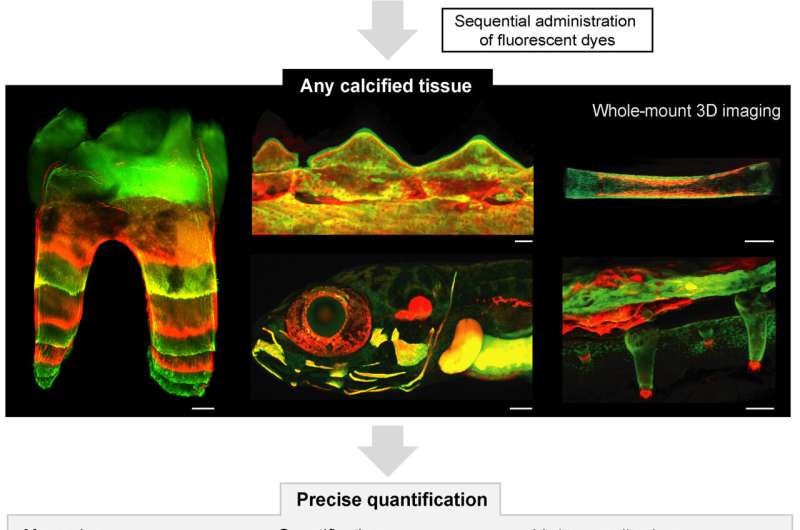
Researchers at Masaryk University, Czech Republic, have innovated a technique to track bone development, growth dynamics and healing in a mouse model. In their paper, “Spatiotemporal monitoring of hard tissue development reveals unknown features of tooth and bone development,” published in Science Advances, the researchers introduce the method and perform a few proof of concept experiments.
BEE-ST (Bones and tEEth Spatio-Temporal growth monitoring) involves administering fluorescent dyes to animals at specific intervals. The dyes then incorporate into mineralizing tissues, allowing researchers to track their growth and changes over time. The dyes are then visualized using confocal or light sheet microscopy to provide detailed three-dimensional images.
The researchers used their BEE-ST approach to analyze the growth dynamics in a mouse model. It enabled precise measurement of incisor growth rate (elongation) and dentin ingrowths (thickening of dentin wall) over time.
In testing, the researchers tracked the turnover rate of continuously growing mouse incisors and could observe the role of a hard and soft diet on molar root growth. The team used two dyes (calcein and alizarin) administered at different intervals and applied imaging techniques to acquire the precise quantification of growth dynamics in terms of length and dentin wall thickness.
BEE-ST was also used to monitor the development of flat bones, such as cranial bones, in newborn mice. Cranial bone fusions, specifically the sagittal and lambdoid sutures, have relevance for understanding congenital malformations like craniosynostosis.
Weekly time points were used to quantify the healing progress of flat bones after skull drilling and observed that healing slows down over time. Bone growth in limbs was also found to follow a nonlinear function of time, observed in sequential dye administrations at specific time points.
While the study serves as a proof of concept in a mouse model, it could be used to quantify development, regeneration, remodeling, and healing in any type of calcified tissue across different species. In further testing, the dynamics of bones and teeth growth in lizards, frogs, birds, and zebrafish were also uncovered.
Aside from providing an internal framework and protection for a body, mineralized tissues, such as the bones that make up the skeletal system, are themselves a critical organ system. Bones store and release minerals, fats, and growth factors critical to homeostasis. Bones also house and produce bone marrow that generates and stores blood cells.
While science has a good understanding of bone development, regeneration, and pathogenesis, BEE-ST is the first tool developed to accurately follow the dynamics of growth and healing of mineralized tissues in a living model with 3D imaging over time.
The BEE-ST method represents a new tool that should open diverse research possibilities in developmental biology, bone and tooth healing, bone tissue engineering, and disease modeling both in vitro and in vivo.
More information:
Marcos Gonzalez Lopez et al, Spatiotemporal monitoring of hard tissue development reveals unknown features of tooth and bone development, Science Advances (2023). DOI: 10.1126/sciadv.adi0482
Journal information:
Science Advances
Source: Read Full Article


